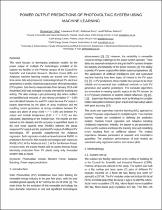JavaScript is disabled for your browser. Some features of this site may not work without it.
- ResearchSpace
- →
- Research Publications/Outputs
- →
- Conference Publications
- →
- View Item
| dc.contributor.author |
May, Siyasanga I

|
|
| dc.contributor.author |
Pratt, Lawrence E

|
|
| dc.contributor.author |
Roro, Kittessa T

|
|
| dc.contributor.author |
Bokoro, P

|
|
| dc.date.accessioned | 2022-02-14T08:13:25Z | |
| dc.date.available | 2022-02-14T08:13:25Z | |
| dc.date.issued | 2021-11 | |
| dc.identifier.citation | May, S.I., Pratt, L.E., Roro, K.T. & Bokoro, P. 2021. Power output predictions of photovoltaic system using machine learning. http://hdl.handle.net/10204/12278 . | en_ZA |
| dc.identifier.isbn | 978-0-7972-1878-9 | |
| dc.identifier.uri | http://hdl.handle.net/10204/12278 | |
| dc.description.abstract | This work focuses on developing prediction models for the power output of multiple PV technologies installed at the outdoor test facility on the Pretoria campus of the Council for Scientific and Industrial Research. Random Forest (RF) and Adaboost machine learning models are trained with historic time-series data sets (measured meteorological and PV electrical parameters) to predict historical output power of the photovoltaic (PV) system. Sub-hourly measured data from January 2019 until November 2019 was averaged to hourly intervals for training and testing. The data undergo a pre-processing step where outliers are identified and removed. A very strong correlation (r2 ~ 0.99) was calculated between Isc and PV output because PV output is largely determined by the plane of array irradiance and the resulting current generation. A strong correlation between PV output and plane of array (0.89 < r2 < 0.99) and between PV output and module temperature (0.62 < r2 < 0.72) are also calculated, depending on the module type. The models are then trained on the datasets and the accuracy is quantified based on the root mean squared error (RMSE) between the actual measured PV output and the predicted PV output of different PV technologies. RF generally outperformed the Adaboost regression. Both regression models achieved minimal RMSE on predictions for the thin film module technologies with maximum RMSE of 0.2 W for Adaboost and 1.2 W for the Random Forest. In future work, the trained models will be used to forecast future electricity production from PV plants using only forecasted weather data as inputs. | en_US |
| dc.format | Fulltext | en_US |
| dc.language.iso | en | en_US |
| dc.relation.uri | https://sasec.org.za/documents/SASEC_2021_Conference_Proceedings.pdf | en_US |
| dc.source | Southern African Sustainable Energy (SASEC) Conference, Lanzerac Wine Estate, Western Cape, 17-19 November 2021 | en_US |
| dc.subject | Photovoltaic module | en_US |
| dc.subject | Random forest | en_US |
| dc.subject | Adaptive boosting | en_US |
| dc.subject | Power output predictions | en_US |
| dc.title | Power output predictions of photovoltaic system using machine learning | en_US |
| dc.type | Conference Presentation | en_US |
| dc.description.pages | 157-162 | en_US |
| dc.description.note | Paper presented at the Southern African Sustainable Energy (SASEC) Conference, Lanzerac Wine Estate, Western Cape, 17-19 November 2021 | en_US |
| dc.description.cluster | Smart Places | en_US |
| dc.description.impactarea | Energy Supply and Demand | en_US |
| dc.identifier.apacitation | May, S. I., Pratt, L. E., Roro, K. T., & Bokoro, P. (2021). Power output predictions of photovoltaic system using machine learning. http://hdl.handle.net/10204/12278 | en_ZA |
| dc.identifier.chicagocitation | May, Siyasanga I, Lawrence E Pratt, Kittessa T Roro, and P Bokoro. "Power output predictions of photovoltaic system using machine learning." <i>Southern African Sustainable Energy (SASEC) Conference, Lanzerac Wine Estate, Western Cape, 17-19 November 2021</i> (2021): http://hdl.handle.net/10204/12278 | en_ZA |
| dc.identifier.vancouvercitation | May SI, Pratt LE, Roro KT, Bokoro P, Power output predictions of photovoltaic system using machine learning; 2021. http://hdl.handle.net/10204/12278 . | en_ZA |
| dc.identifier.ris | TY - Conference Presentation AU - May, Siyasanga I AU - Pratt, Lawrence E AU - Roro, Kittessa T AU - Bokoro, P AB - This work focuses on developing prediction models for the power output of multiple PV technologies installed at the outdoor test facility on the Pretoria campus of the Council for Scientific and Industrial Research. Random Forest (RF) and Adaboost machine learning models are trained with historic time-series data sets (measured meteorological and PV electrical parameters) to predict historical output power of the photovoltaic (PV) system. Sub-hourly measured data from January 2019 until November 2019 was averaged to hourly intervals for training and testing. The data undergo a pre-processing step where outliers are identified and removed. A very strong correlation (r2 ~ 0.99) was calculated between Isc and PV output because PV output is largely determined by the plane of array irradiance and the resulting current generation. A strong correlation between PV output and plane of array (0.89 < r2 < 0.99) and between PV output and module temperature (0.62 < r2 < 0.72) are also calculated, depending on the module type. The models are then trained on the datasets and the accuracy is quantified based on the root mean squared error (RMSE) between the actual measured PV output and the predicted PV output of different PV technologies. RF generally outperformed the Adaboost regression. Both regression models achieved minimal RMSE on predictions for the thin film module technologies with maximum RMSE of 0.2 W for Adaboost and 1.2 W for the Random Forest. In future work, the trained models will be used to forecast future electricity production from PV plants using only forecasted weather data as inputs. DA - 2021-11 DB - ResearchSpace DP - CSIR J1 - Southern African Sustainable Energy (SASEC) Conference, Lanzerac Wine Estate, Western Cape, 17-19 November 2021 KW - Photovoltaic module KW - Random forest KW - Adaptive boosting KW - Power output predictions LK - https://researchspace.csir.co.za PY - 2021 SM - 978-0-7972-1878-9 T1 - Power output predictions of photovoltaic system using machine learning TI - Power output predictions of photovoltaic system using machine learning UR - http://hdl.handle.net/10204/12278 ER - | en_ZA |
| dc.identifier.worklist | 25380 | en_US |






